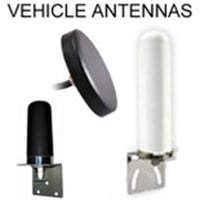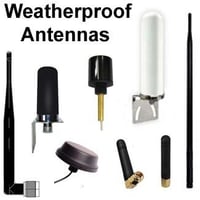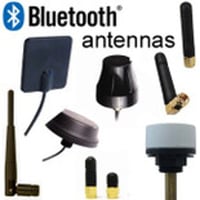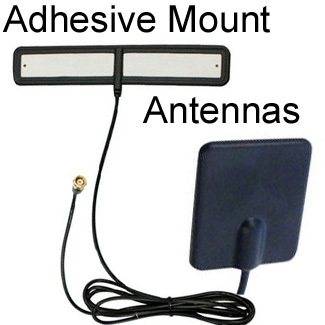Signal Boosters
WiFi Booster / Amplifier - Extend Signal Range:
A WiFi booster is a device that is used to “boost” or extend the range of a WiFi signal. They may also be described as:
- WiFi signal booster antennas
- WiFi signal amplifiers
- WiFi range extenders
WiFi boosters extend WiFi coverage into areas where the signal is low or of poor quality. The WiFi signal can be degraded by walls, construction materials like concrete or metal, as well as interference from devices that operate using WiFi frequencies (e.g. cordless phones or microwaves). A WiFi signal amplifier is able to utilize an existing WiFi signal, amplify it and rebroadcast the strengthened signal into a WiFi dead zone, or extend a WiFi signal over a significant distance. They provide an effective solution for providing WiFi coverage that can be used by a wide range of wireless networked devices.
Connect the WiFi signal amplifier to your access point or router.
Wi-Fi signal boosters can be connected to routers or access points. They typically boost the source signal that is generated by the router, and where effective, can increase signal strength by a factor of three. A bi-directional WiFi signal booster is capable of amplifying both received and transmitted WiFi signals for a boost in signal strength that can be as much as 600%.
WiFi signal amplifiers are key to providing seamless connectivity in a variety of environments. For mission-critical sectors and applications, the installation of a WiFi signal booster can safeguard network performance.
WiFi signal boosters are distinct from WiFi repeaters which simply repeats and rebroadcasts an acquired WiFi signal without amplifying it.
WiFi booster applications:
WiFi signal booster increase signal range and throughput for a variety of 802.11 applications including:
- Wireless hotspots
- Wireless bridges
- 802.11 LAN networking
- Internet of Things
Signal boosters are extremely versatile devices that hold great potential to enhance wireless coverage in areas where signal levels are diminished. They are easily installed in properties to provide coverage for devices that are part of a local area network. They may also be used in a variety of public settings like sports stadia, train stations or airports where networks may be heavily subscribed.
WiFi signal amplifier frequencies
WiFi signal boosters are designed to work with WiFi frequencies in the 2.4 GHz frequency band (between 2.4 and 2.5 GHz). This makes them compatible with the following 802.11 versions of WiFi networking that use the 2.4 GHz frequency band:
- 802.11b (legacy WiFi)
- 802.11g (WiFi 3)
- 802.11n (WiFi 4)
- 802.11ax (WiFi 6)
Booster performance is especially important as data loss/signal attenuation from wireless devices is common. Often the wireless network cards used in laptops, routers and other devices are not very strong, with limited power and range. A bidirectional signal booster with an antenna can enhance the performance of the client device within a WiFi network.
How does a WiFi signal booster work?
WiFi bi-directional boosters are relatively simple electronic devices that can receive the signal from a router or access point and amplify them within the network, they also receive incoming signals from networked devices and amplify and forward those to the router.
They carry a transmitting antenna and a receiving antenna that is connected to an intermediate amplifier.
An intermediate amplifier is a WiFi booster component that is capable of raising the signal level. It works with frequencies that are intermediate to the radio signal from the receiving antenna and the signal from the direct radio source. These electronic components possess a variety of circuits including mutual inductance or shunt capacitance coupling or the use of transformers.
The intermediate amplifier receives direct input from the radio signal source (router/access point/wireless card). The intermediate amplifier uses the received signal from the antenna and the signal from the radio source, amplifying the difference between them. The signal is then processed by a Low Noise Amplifier (LNA), removing any unwanted signal present and further amplifying the signal. The signal is then transferred to be rebroadcast via the transmitting antenna.
The LNA can amplify the received signal without significant degradation of the signal to noise ratio (SNR). Unlike the amplifier that increases both signal and noise, the LNA will minimize the noise in the amplified signal.
- WiFi booster antennas
WiFi signal boosters carry paired high gain external WiFi antennas, usually located on opposite sides of the device. Internal antennas are not suitable for WiFi boosters as they cause interference within the device, negatively affecting its performance.
At least one external high gain WiFi antenna is directed towards the access point. This antenna may be directional. The other antenna (ideally with a large beamwidth), will be the broadcasting antenna that provides the necessary coverage.
- WiFi signal booster antenna cable
If a coaxial cable is used with the external antennas of a WiFi signal amplifier, the antenna cable should be low-loss and kept as short as possible. We recommend our high-quality, double-shielded LMR 100 analogue cable for making any required connections.
- WiFi signal amplifier specifications
WiFi signal boosters can be standalone plug-and-play devices or wireless modules that are embedded in a wireless device.
[A] Ready to use 800mW 802.11 WiFi bidirectional signal booster module
This bi-directional booster module is capable of increasing WiFi area coverage by up to four times the coverage of a standard wireless access point. It is designed to connect to an access point or router to provide a signal boost.
Key physical specifications of 800mW 802.11 WiFi bidirectional signal booster module
The signal booster carries:
- Gold-plated RP-SMA female connector for Access Point or (other 2.4-2.5 GHZ source) input
- Gold-plated RP-SMA female connector for WiFi antenna output
- 5VDC 500mA max DC input (jack)
- 3 status LEDs: Power - green, Transmitting - Red, Receiving - Amber
Dimensions: 2.36 x 0.7 x 0.31 inches (60 x 17.77 x 8 millimeters)
Weight: 7.30g
Key electrical specifications of 800mW 802.11 WiFi bidirectional signal booster module:
- Frequency range: 2.4 to 2.5 GHz
- RP-SMA connector impedance: 50 Ohm
- Signal type/modulation: Direct Sequence Spread Spectrum/ Orthogonal frequency-division multiplexing
- Receiving maximum input power: -10dBm
- Receiving maximum power gain: 13dB
- Transmitting maximum linear output: 500mW / +27dBm
- Transmitting maximum power gain: 13 dB
- Transmitting maximum input power: 20dB
- Power supply: DC 5V/500mA
[B] 800mW 2.4 GHz pen booster
This simple to use pen booster is designed to work with 802.11 access points and routers. It is compact and quick to install (with no programming) on an existing 802.11 wireless device via its RP-SMA male connector. It can double the range of a variety of wireless devices (including wireless CCTV cameras) that use the leading versions of WiFi that operate at 2.4 GHz, as well as Bluetooth and ZigBee.
Key physical specifications of 800mW 2.4 GHz pen booster
The signal booster carries:
- Right-angled RP-SMA male connector for Access Point or (other 2.4-2.5 GHZ source) input
- RP-SMA female connector for WiFi antenna output
- DC 6V/1A max DC input (jack)
- 3 status LEDs: Power - green, Transmitting - Red, Receiving - Amber
Dimensions: 6.1 x 0.85 inches (155 x 21.6 millimeters)
Weight: 20g
Key electrical specifications of 800mW 2.4 GHz pen booster
- Frequency range: 2.4 to 2.5 GHz
- RP-SMA connector impedance: 50 Ohm
- Signal type/modulation: Direct Sequence Spread Spectrum
- Receiving maximum input power: -10dBm
- Transmitting maximum linear output: 500mW / +27dBm 800mW / +29dBm
- Transmitting maximum input power: 20dB
- Power supply: DC 6V/1A
Regulatory guidance and considerations for the use of WiFi signal boosters
In the US, the use of signal boosters and their attached antennas is subject to regulation by the Federal Communications Commission (FCC).
The FCC is concerned that malfunctioning or poorly designed or installed signal boosters can cause interference with wireless networks and other critical communication services including emergency and law enforcement.
Over time, stakeholders in the communications sector have filed multiple petitions seeking clarification on the FCC rules that oversee the use and regulation of WiFi signal boosters. After undertaking public consultation and investigation regarding how best to support the design and deployment of signal boosters, the FCC rules have been updated (2014 and later in 2018) to reflect the accelerating changes in wireless networking. The aim has been to broaden the access and availability of wireless signal boosters while balancing their use against the potential for adverse effects on critical wireless networks.
FCC guidance covers wireless signal boosters but is predominantly focused on cellular boosters rather than WiFi boosters. WiFi boosters are legal as long as they comply (where applicable) with the rules that prevent interference to wireless networks. They do not need to be registered with or licensed by the FCC. These were last updated in 2018. WiFi signal boosters operate in the 2.4 GHz frequency band which is an unlicensed ISM band and therefore are not expected to interfere with the licensed spectrum if they are operating competently. The only concern is the amount of radiated power they emit, which is specified in the technical aspects of the regulations below.
FCC guidance: Title 47 - Telecommunication Chapter - Subchapter B Part 20 - 20.21 Signal boosters
Key takeaways for WiFi signal boosters:
The FCC classifies signal boosters as Consumer Signal Boosters and Industrial Signal Boosters. The type of signal booster should be clearly labelled by the manufacturer, as well as its compliance with FCC regulations if operated normally.
- Consumer Signal Boosters: These are plug-and-play wireless signal boosters that are designed for private individual use within homes or recreational vehicles like a boat.
- Industrial Signal Boosters: Cover a broad range of devices that are for licensed use or that require professional installation. They are typically used to provide coverage for multiple uses in public settings like hospitals or airports. Any boosters of this nature manufactured for purchase since March 2014 must comply with the FCC requirements.
Consumer WiFi signal boosters should only be used with antennas, cabling and other coupled devices that have been specified and approved by the manufacturer of the signal booster.
Users should not modify or deactivate features of a consumer signal booster that are designed to prevent harmful interference. These features must be fully enabled and operative for the duration the signal booster is in use.
WiFi signal boosters should not cause harmful interference to the operations of primary licensed services. This is unlikely in the 2.4 GHz frequency band. If requested by FCC representatives, an operator of a signal booster must assist in determining the source of any interference, deactivating the signal booster immediately where it is deemed necessary.
They must also have controls that prevent excessive input signals that can cause the output power to exceed authorized levels (gain control) and be able to detect and mitigate oscillations in the uplink and downlink bands (anti-oscillation).
Wireless WiFi boosters can only be certificated and used if they are compliant with all applicable technical rules for their frequency band. Signal boosters that operate in unlicensed frequency bands must be designed and manufactured to only operate on the frequencies designated for providing their specified signal coverage. They must also utilize interference avoidance methods to prevent interference being transmitted into the Commercial Mobile Radio Services (CMRS) Spectrum.
The FCC has also imposed the following technical requirements:
- Transmitted noise power of consumer boosters at their uplink port is limited to -103 dBm/MHz
- Bidirectional signal boosters should have equivalent uplink and downlink gain. The conducted uplink power output should be a minimum of 0.05 watts.
- Consumer boosters have an uplink gain limit of -34 dB
- Booster uplink power must not exceed 1 watt in conducted power or equivalent isotropic radiated power (EIRP).
- Downlink power/EIRP should not exceed 0.05 watt/17 dBm.
What is EIRP?
Equivalent Isotropic Radiated Power (EIRP) is calculated as the total radiated power from a transmitting antenna multiplied by the directivity (gain) of that antenna in the direction of the receiver. It can be quickly calculated by multiplying the input power delivered to the antenna by the numerical gain of the antenna.







